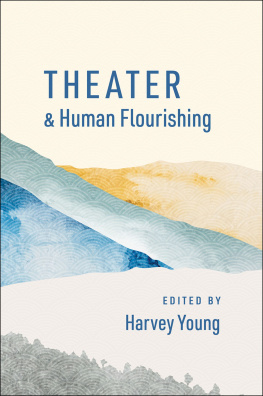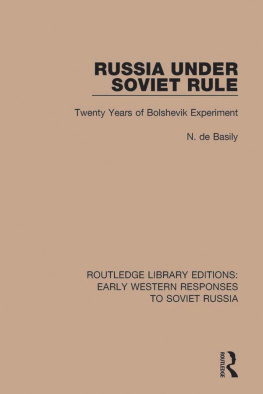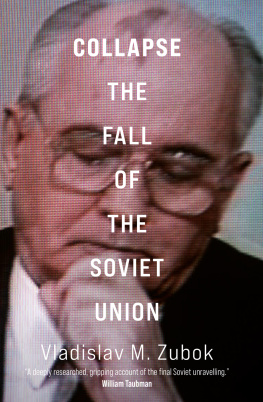THE SOVIET THEATER
THE SOVIET THEATER
A Documentary History
Edited by
Laurence Senelick and Sergei Ostrovsky

All pictures come from the Laurence Senelick Collection.
Copyright 2014 by Yale University.
All rights reserved.
This book may not be reproduced, in whole or in part, including illustrations, in any form (beyond that copying permitted by Sections 107 and 108 of the U.S. Copyright Law and except by reviewers for the public press), without written permission from the publishers.
Yale University Press books may be purchased in quantity for educational, business, or promotional use. For information, please e-mail sales.press@yale.edu (U.S. office) or sales@yaleup.co.uk (U.K. office).
Design and typography by Concord Editorial and Design.
Printed in the United States of America.
Library of Congress Cataloging-in-Publication Data
The Soviet theater : a documentary history / edited by Laurence Senelick and Sergei Ostrovsky.
pages ; cm
Includes bibliographical references and index.
ISBN 978-0-300-19476-0 (cloth : alk. paper) 1. TheaterSoviet UnionHistory. 2. TheaterSoviet UnionHistorySources. 3. Theater and stateSoviet UnionHistory. 4. Theater and stateSoviet UnionHistorySources. I. Senelick, Laurence, editor. II. Ostrovsky, Sergei, editor.
PN2724.S65 2014
792.0947dc23
2013044557
A catalogue record for this book is available from the British Library.
This paper meets the requirements of ANSI/NISO Z39.481992 (Permanence of Paper).
10 9 8 7 6 5 4 3 2 1
For Inna Solovva and Anatoly Smelyansky, sine qua non
Gather up the fragments that remain, that nothing be lost.
Gospel of St. John
Theater is a living spiritual and intellectual focus, a place for social self-awareness, a vanishing point where all the lines of force of the age meet, a seismograph of the times, in space, an area of freedom, an instrument of human liberation.
Vclav Havel, Disturbing the Peace
Contents
Preface
The Soviet theater may be the best documented in history. With the possible exception of France, no other government devoted so much of its attention to theatrical matters and generated so much paper in that regard. The administration and its bureaucracies produced legislation, transactions, and red tape. In addition, Russian artists were people of the word. Following the example of the Moscow Art Theater, directors and companies preserved records of rehearsals, stage plans, sketches for designs, photographs, every scrap of paper associated with a production. A lively theatrical press proliferated editorials, reviews, roundtables, profiles, character studies, and surveys. In a society in which any public utterance might be subjected to close scrutiny by the powers-that-be, individuals expressed themselves privately in letters, diaries, journals, and personal memoirs. At times it seems as if almost every Soviet citizen concealed a written testament to his individuality in the face of enforced conformity.
The oft-quoted remark in Bulgakovs novel The Master and Margarita that manuscripts do not burn looks less paradoxical in view of the Russian reluctance to destroy documents. Unlike the Nazis, the Soviet political police seldom conducted conflagrations of written or published material. A sheaf of papers might be confiscated, but most usually, it was preserved in the government archives, either as collateral evidence or in case its author might return to favor. Occasionally, material in danger of such confiscation might be privately secreted away. The most famous case of this is the Meyerhold archive. In 1939, a few days before Meyerholds arrest, his wife, herself about to be murdered, entrusted the archive to Sergey Eisenstein, who hid it in his dacha. It was intact and available for publication when Meyerhold was rehabilitated in 1955.
The resurfacing of this documentation was important to the continued health of the theater. Many of those who had fallen into disfavor had become nonpersons, their names and careers erased first from playbills and programs, then from the histories. The document was often the only testimony that a certain person had existed and accomplished anything. Rather than obliterating, the Soviet authorities became expert at retouching, refashioning reality so that, instead of a gaping lacuna, a softened, reassuring image could be provided. This explains why, with the collapse of the Soviet Union, a favorite form of publication is the collection of documents. Sometimes a publishing house is founded solely for the purpose of making public a mass of documentation.
When the USSR imploded in 1991, it provided fresh new opportunities for scholarship. Archives and collections were opened to researchers, but, as many realized, the window might be slammed shut again at any time. We therefore decided to take advantage of the opportunity and plunge into the mass of material to compile a history of the Soviet theater based on original documents. A generous grant from the National Endowment for the Humanities enabled us to devote two years to exploring archives in Russia, Israel, and the United States, in the process collecting a vast fund of material, much of it unpublished or never republished after its first appearance in a periodical.
The topic was attractive in its seeming discreteness: it could be bounded by the dates 1917, when the October Revolution marked the beginnings of Soviet power, and 1991, when the USSR disintegrated. Conversely, the field was vast, seeming to cover all the constituent republics and divagating into such topics as migr theater. With such an embarras de richesses, we would have to be highly selective. Until the materials had been collected and sorted, however, it was unclear where our emphases would lie. Eventually, certain productions and individuals retained their prominence, whereas others proved to be of equivalent interest.
Another factor that impelled this project was that no comprehensive history of the Soviet theater existed in English. Books either included chapters on it or were devoted to specific periods or individuals. Certain figures, such as Meyerhold, Vakhtangov, Stanislavsky, Bulgakov, and Lyubimov, were given pride of place, for obvious reasons, but turning the spotlight on these eminences left large tracts of activity in shadow. Separate monographs were devoted to such topics as childrens theater, puppetry, the Yiddish stage, and censorship, but the close focus blurred the context. Earlier attempts by its participants to write of the Soviet theaters evolution, such as those of Nikolay Gorchakov and Yury Elagin, were often distorted by parti pris and were wielded as weapons in the Cold War.
Yet, to leach out the political element would be a different kind of distortion. In 1988, the veteran Soviet theater critic Konstantin Rudnitsky published a survey of Russian and Soviet theater from 1905 to 1933, intended for an English-language readership. Rudnitsky was steeped in the subject and had personally suffered from the Stalinist attack on cosmopolitans in the 1950s. Yet the only mention of Stalin in his book was in a picture caption, and Rudnitskys choice of dates clearly showed a reluctance to deal with the repressions and purges that arrived with the Second Five-Year Plan. The brilliant theatrical achievements of the 1920s and early 1930s therefore come across, in Rudnitskys account, as either spontaneously generated or stimulated by the artistic creations of others.
The fact is that, by definition, the Soviet theater was so tightly intertwined with politics that what happened in it has to be seen as a reaction to the constantly changing policies of the government. We are not dealing with independent artists creating in a vacuum, nor even with theater folk responding to the tastes of an audience. Art for arts sake plays no role here. In the USSR, almost from the first, the theater is, in one way or another, a reflection of the governments mood. How theater is to serve society is dictated from above: one may oppose that diktat or find idiosyncratic ways to serve it, but it cannot be avoided.
Next page







